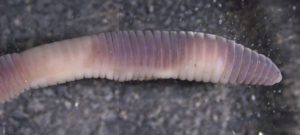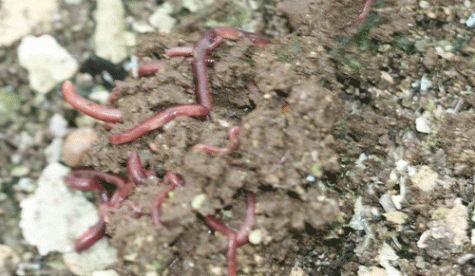Litter Worm Update
Photo: A group of litter worms (Bimastos heimburgeri) in one of our compost piles.
I previously blogged about finally finding a lab to identify our scuds, litter worms, and vat worms. For information about the scud identification and some background see these blogs:
https://goliadfarms.com/maybe-i-can-get-some-invertebrates-identified-finally/
https://goliadfarms.com/update-on-gammarus-identification/
https://goliadfarms.com/shop/gammarus-scuds/
While sending our scuds to Anndrea Navesky and Matt Hill of EcoAnalysts, Inc. (see https://www.ecoanalysts.com/), an aquatic bioassessment company, I also included some of our litter worms. We got our start of litter worms in 1997 while our hatchery was in Santa Fe, New Mexico, about four years before our move to south Texas. We had been told they were Lumbricus rubellus, one of the two common worms sold as litter worms. The other species being Eisenia foetida. Neither of these worms are native to North America.
Not long after we got the worms I began to wonder if they were correctly identified. They didn’t seem to match either Lumbricus rubellus or Eisenia foetida in either physical description or behavior. Our worms preferred with wet conditions. They are very cold hardy. In Santa Fe, which at 7,000 feet has very cold winters, we kept them in a large compost pile. One winter I broke off a piece of frozen compost and placed it in our warm greenhouse. As the ice melted, the worms came to life and crawled away.
Then, over the years, I shipped the worms to a number of educational institutions. Some of the recipients told me the worms weren’t Lumbricus rubellus. When I suggested they were maybe Eisenia foetida instead, I was told they weren’t. A few researchers promised to key them out and let me know what they were, but that never happened. So, when Anndrea offered to get them keyed out, I jumped at the chance.
In addition to the worms that occupied our compost beds, which we keep wet with excess plants and detritus (we refer to that as “gunk”) from vat cleaning, I’d noticed some smaller worms living around the water line in vats without predatory fish. They seem to like the damp algae growing at the water line, but also lived in the water, apparently fully aquatic. We have Tubifex living in some of our livebearer vats (see https://goliadfarms.com/tubifex-worms/), but these were larger and looked more like miniatures of our litter worms. Since finding them, I had always wondered if our litter worms were colonizing our vats. Calling them “vat worms,” I sent a few of them along with the litter worms to Anndrea and Matt.
Not long after Matt finished up with the scuds, I got an email from him stating,
“I got the compost worm identified, I’m calling it Bimastos heimburgeri. Anndrea and I have taken to calling it Bimastos hamburgleri : ) This worm is in the same family as Lumbricus rubellus and Eisenia fetida, (Lumbricidae), but is native to eastern North America. Both L. rubellus and E. fetida are introduced from Europe. I can’t find much else on this species, but I’ll keep looking and pass along anything I find. I’ve attached some photos of a specimen (whole and dissected), feel free to put them in your blog if you’d like. I’m still working on putting a name on the vat worms, I’m pretty sure they are a different species.”
So, after years and years of trying to determine what our litter worms are, we finally have a name. Note the taxonomy nerd humor, “Anndrea and I have taken to calling it Bimastos hamburgleri : )” Cute!
Below is one of the photos Matt sent. It is an intact worm. I didn’t include the photos of the dissected worms to protect the squeamish, but if you want them, email me and I’ll forward them to you.

Now that we have a certain identification, thanks to Matt and Anndrea, Susie (wife and business manager) is after me to update our website. I’ll do so by changing the worm’s name and including a link to this blog.
By the way, Matt subsequently told me the vat worms are in fact TWO entirely different species. I’ll blog about them shortly.
Good fishkeeping!


Brian Laniewicz says
I am looking into getting something set up to start raising scuds as live food for some of my fish and will be ordering those from you once I have it set up. I live in upstate New York, so want to set something up both indoors and outdoors. But I was also wondering if you happen to feed any of your litter worms to your fish (cichlids or livebearers), or are they only used in the compost piles?
Are there any sort of potential disease/health issues (in regards to the fish or aquarium environment) that might arise by feeding either the scuds or litter worms to aquarium fish? If so what do I need to watch for and how best to eliminate/mitigate those issues?
Thanks, Brian
Charles Clapsaddle says
Brian,
I occasionally feed the litter worms to fish but mainly use them to create compost.
Worms are fatty and probably should only be fed occasionally. They are very good when conditioning female cichlids for breeding since they require fat for egg production.
Scuds, I suppose, like all related arthropods, could be hosts to internal parasites, but I’ve never seen that. Scuds will eat plants if they over-populate. I wouldn’t trust them with unguarded eggs like those of most tetras and barbs. In our dense colonies, they quickly eliminate snails.
I see no real problems with litter worms as long as they aren’t a significant portion of your fishes’ diets. You would want to avoid feeding too many at time. A decomposing, uneaten worm could cause problems.
As to scuds, it’s important to keep the population under control. That is rarely a problem in most aquaria with adequate fish to eat them. I do caution against using them in tanks with few fish and some expensive plants.
Charles